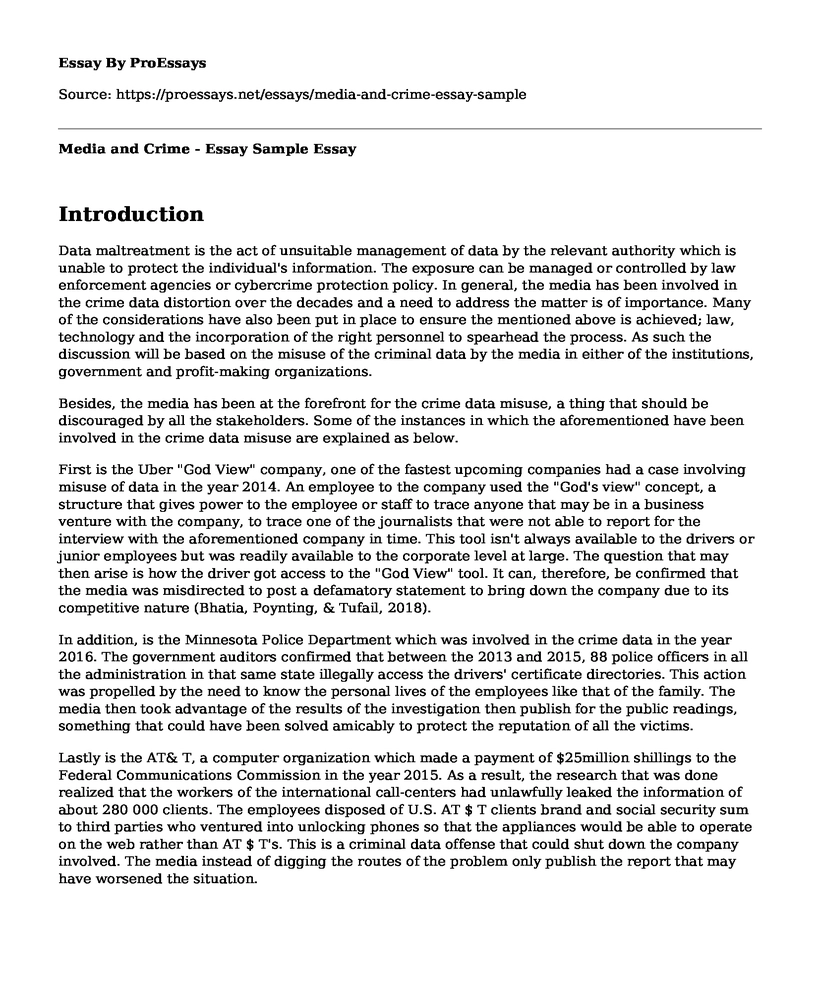Introduction
Data maltreatment is the act of unsuitable management of data by the relevant authority which is unable to protect the individual's information. The exposure can be managed or controlled by law enforcement agencies or cybercrime protection policy. In general, the media has been involved in the crime data distortion over the decades and a need to address the matter is of importance. Many of the considerations have also been put in place to ensure the mentioned above is achieved; law, technology and the incorporation of the right personnel to spearhead the process. As such the discussion will be based on the misuse of the criminal data by the media in either of the institutions, government and profit-making organizations.
Besides, the media has been at the forefront for the crime data misuse, a thing that should be discouraged by all the stakeholders. Some of the instances in which the aforementioned have been involved in the crime data misuse are explained as below.
First is the Uber "God View" company, one of the fastest upcoming companies had a case involving misuse of data in the year 2014. An employee to the company used the "God's view" concept, a structure that gives power to the employee or staff to trace anyone that may be in a business venture with the company, to trace one of the journalists that were not able to report for the interview with the aforementioned company in time. This tool isn't always available to the drivers or junior employees but was readily available to the corporate level at large. The question that may then arise is how the driver got access to the "God View" tool. It can, therefore, be confirmed that the media was misdirected to post a defamatory statement to bring down the company due to its competitive nature (Bhatia, Poynting, & Tufail, 2018).
In addition, is the Minnesota Police Department which was involved in the crime data in the year 2016. The government auditors confirmed that between the 2013 and 2015, 88 police officers in all the administration in that same state illegally access the drivers' certificate directories. This action was propelled by the need to know the personal lives of the employees like that of the family. The media then took advantage of the results of the investigation then publish for the public readings, something that could have been solved amicably to protect the reputation of all the victims.
Lastly is the AT& T, a computer organization which made a payment of $25million shillings to the Federal Communications Commission in the year 2015. As a result, the research that was done realized that the workers of the international call-centers had unlawfully leaked the information of about 280 000 clients. The employees disposed of U.S. AT $ T clients brand and social security sum to third parties who ventured into unlocking phones so that the appliances would be able to operate on the web rather than AT $ T's. This is a criminal data offense that could shut down the company involved. The media instead of digging the routes of the problem only publish the report that may have worsened the situation.
Conclusion
In conclusion, for so long, the media has made it possible for the public to know more about crimes but have not been able to educate or inform the public on the dangers of any crime committed. This has ensured an increase in the number of criminals all over the world. It would, therefore, be necessary for the media to reduce airing or giving out the criminal data if they cannot find an appropriate solution that can reduce the increase in the data crime rates.
Reference
In Bhatia, M., In Poynting, S., & In Tufail, W. (2018). Media, crime and racism.
Cite this page
Media and Crime - Essay Sample. (2022, Dec 19). Retrieved from https://proessays.net/essays/media-and-crime-essay-sample
If you are the original author of this essay and no longer wish to have it published on the ProEssays website, please click below to request its removal:
- Reflection on the Book "Just Mercy"
- Interview Example on the Influence of Social Media on Societal Values
- Paper Example on Sentencing with Diverse Population Groups
- Women in Movies Annotated Bibliography
- Cinematic Adaptation: Key Skill for Film Production Success - Essay Sample
- Essay Sample on Exploring the Causes of a Litigation Explosion in the Courts
- Paper Example on Analysis of Cultural Dance: Abstrait & Clay Figures







